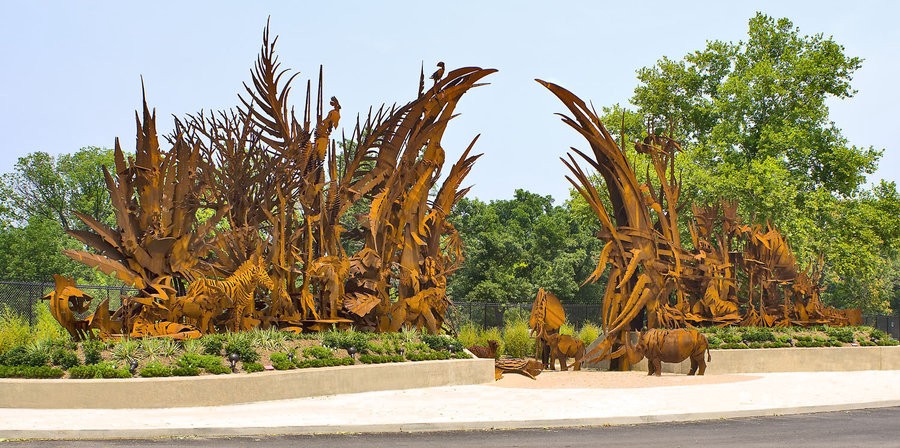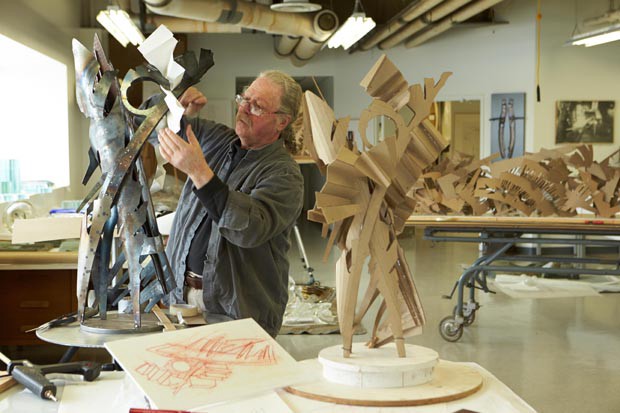
Our team is always blown away by the useful advice Highrise customers are willing to share with us. Here’s another we think you’ll want to hear.
Paley Studios has been using Highrise daily since 2007 to help organize various projects, information and contacts.
It’s an invaluable online resource that allows us to keep project information, for multiple projects, organized and instantly accessible no matter where in the world we are working from.
But this isn’t about Highrise; it’s a story about Albert Paley, a world famous artist, and it’s a lesson in exploration, learning, and… having a plan B.
Diversify. Learn to be good at one thing many ways.
Albert Paley is a lifelong artist. He was the first metal sculptor to receive the coveted Lifetime Achievement Award from the American Institute of Architects, the AIA’s highest award for a non-architect.
You might have seen his work on Park Avenue in New York City. You’ll see his massive sculptures outside of national museums, the St. Louis Zoological Park, or maybe you’ll even find piece of his unique furniture at one of your friends’ houses.
And when you see his work, you’ll know it’s his.
Why?
As the director of Paley Studios, Jennifer Laemlein shares, “you can definitely see Albert Paley design. You can see elements he uses. The combination of the geometric and the organic. The ribbons and the flow of the steel.”

Nothing about Paley’s work is shy. It’s not timid. Or submissive.
Laemlein continued, “he tends to like to do large public art. We’re generally working in the realm somewhere from 50 to 100 feet tall.”
To put that in perspective, these sculptures range from 5 to 10 stories high or wide.
Albert Paley’s work is physical. It’s bold. Big. Aggressive.
So how did Paley get his start?
Albert Paley has been making things out of metal for over 40 years. Paley started as a goldsmith making jewelry.
Paley has always been an artist. His goal with designing jewelry was to do something that hadn’t been done before. It was to explore.
And he did. His jewelry was approached as a sculpture art form to adorn the human body. The oversized pieces responded to the shape and movement of the wearer.
But Paley had bigger ambitions for his work. He understood iron and transformed himself to work on larger scale projects. He embraced architecture.
In 1975, Paley described what he does as, “a lot of my work has to do with exploration. Exploration of processes. Within the metal field, there is great diversity of process orientation. I felt that with metal I had the flexibility of exploration that I didn’t have in any other medium… There is no limitation whatsoever.”
Paley’s process of designing is like his personality. It’s intense. The process is always evolving and changing shape depending on what Paley is creating.
For most works, the first step of the process is lots of sketches on paper.
Paley’s wife, Frances, claims he doesn’t know even how to turn a computer on and he has no email address.
He would rather sit with a pencil and piece of paper. That’s where he likes to work from. Very basic.
For Monumental public art projects, he starts with hundreds of drawings to build a matrix. Paley then selects what’s most important from the drawings and creates 3-dimensional sketches using cardboard. This helps with understanding angles and developing a visual vocabulary. This takes Paley to a metal model, a smaller version of the sculpture. The studio might go through 3 to 5 different cardboard and metal models before beginning to build the sculpture at full scale.
Once at full scale, Paley and his staff work in stages to complete the large sculptures. There are fabrication and forging stages that can take months to complete.

Today, he could be described as a goldsmith, an artist, a blacksmith, a sculptor, or an architect. But in the truest form, Albert Paley is an explorer.
He is in constant pursuit of creativity. And his definition of creativity is refreshing.
So many people think of creativity in artistic pursuits. But creativity is just a fundamental human condition. You build on a vocabulary. On a foundation to build a concept or understanding,
If you’re already dealing with your understanding on an order of things, that’s something that you already know. Where real innovation comes in is getting those things that are unknown.
It comes from exploring and discovering what you’re capable of doing. And each of Albert’s projects is bigger and more ambitious than the last.
In 2013, Paley created 13 unique landscape sculptures for a 6-month exhibition on Park Avenue in New York City, the largest exhibition ever on the famous avenue.
Like Paley, this project wasn’t tepid or ordinary. This project was brash and exhaustive. It was ambitious.
Watch more about the project:
Elizabeth Cameron, archivist at Paley Studios, describes the installation process:
In June 2013, over the course of 2 nights we installed 13 landscape sculptures for exhibition on Park Avenue in New York City. Imagine the communication and permitting necessary for shutting down sections of Park Avenue overnight, while running 2 crane and installation crews at the same time as the 13 flat-bed tractor trailers loaded with 15–20 foot sculptures are waiting across the river in New Jersey. The sculptures are radioed in two at a time. There 2 film crews there, other photographers and media too. Then imagine doing it all in reverse six months later when the exhibition ends and all the sculptures have to ship to their new homes.
That’s a serious project and one that requires the help of an entire staff. While Paley started as a one-man band, his staff includes 14 people who help him toward his creative vision.
The studio is constantly prototyping or building something. And what they’re building is usually large, so any mistakes will be costly.
The staff thrives on this challenge. Jeffrey Jubenville, a foreman at the studio, confesses, “it’s very fulfilling, and that’s what is important to me. Being challenged daily. There are probably 200 items on the the floor at one time. There are pieces everywhere, all under different stages of development.”
The studio’s archivist agreed with Paley’s advice around exploring and learning to be good at one thing many ways:
Albert’s ability to create on multiple streams has allowed the studio to continue to exist during lulls in the various markets. So when public art is slow the galleries pick up, or when the galleries are slow the commissions pick up. Always have a plan B.
And keep exploring.
P.S. If you need help keeping track of who you talk to and what you talk to them about, please take a look at Highrise. It’s a simple tool to manage your communication with others. And be sure to follow us on Twitter: here.

